On Sunday we slept in and then headed over to Philadelphia. We decided to make a quick stop over at Valley Forge on the way. We first went to the visitor center and museum.
It was interesting to read about the time the Continental Army spent at Valley Forge.
It was interesting to read about the time the Continental Army spent at Valley Forge.
On December 19, 1777, Washington's army marched into camp at Valley Forge. They were tired, cold and ill-equipped. This was following two losses at Brandywine and Germantown and the loss of their capital at Philadelphia. . When the troops arrived they were disheartened and tired. What followed the next 6 months was not what they had imagine and was not quite the respite the army needed.
The continental army camped at Valley Forge from December 1777 to June of 1778. The winter was harsh. Many soldiers were already shoeless and their uniforms in tatters. It was typical, in that time, for armies to cease combat during the coldest months. Washington was looking for a place to rest his army that would have supplies, such as wood, water and forage but would also by secure from surprise attacks. So General Washington settled on Valley Forge.
Here is my own little Washington, posing for me at the visitors center.
Tanner and Dad loved the gun displays at the museum.
Here is the General Washington display inside the Visitors Center.
So the troops arrived at Valley Forge in time for Christmas. Unfortunately there was no holiday feast. The men survived on "fire cakes" and cold water. A fire cake was simply a flour and water batter fried on the griddle. You can imagine how tasteless that must have been. The first priority was the building of huts. General Washington issued an order specifying the style and size of the quarters.
Every 12 men shared a 16X14 foot log hut with walls six and half feet high. Each hut had a stone fireplace and the roofs were made of wood boards. The huts didn't typically have doors, except for a cloth covering. The huts were drafty, damp, smokey and very unsanitary.
Every 12 men shared a 16X14 foot log hut with walls six and half feet high. Each hut had a stone fireplace and the roofs were made of wood boards. The huts didn't typically have doors, except for a cloth covering. The huts were drafty, damp, smokey and very unsanitary.
We got to explore the camp itself and saw some of the huts.
With the housing situation under control, the next challenge was clothing and food. Transportation was a major struggle. The supplies were out there, but getting them to Valley Forge seemed impossible. The roads were terrible and difficult to maneuver. And the continental dollar was basically useless at this point, so many farmers didn't want to contract with the army because there was no profit. In the spring, Washington's most capable general, General Nathanael, took over as Quartermaster for the camp and supplies miraculously began to move again.
However, the soldier suffered greatly during the winter months. Illness, not musket balls, was the great killer during this time. More than 2,500 soldiers died at Valley Forge. Much of the sickness was traced to unhealthy sanitation and poor hygiene. But other deaths were attributed to starvation and exposure. Washington actually complained a lot about the failure to clear the camp of filth, including the rotting carcasses of horses. GROSS!! General Washing also issued orders concerning the use of "privies" but the men seem to do their business wherever they wanted. Including relieving themselves upstream of where the water was drawn. Eventually the men were threaten with 5 lashes if they didn't not use the privies. Seriously- Boys are gross.
It is recorded how Washing expressed deep gratitude to the men who remained at Valley Forge and continued to serve- when many tried to desert. He knew the conditions were terrible. He described men marching without clothes, blankets or shoes-leaving bloody trails in the snow. So sad!
In the Spring, Baron Friedrich Von Steuben, a Prussian drill master, was brought in to train the troops. He began to magically transform the threadbare troops into a fighting force. He tirelessly drilled the soldiers, improving their battle and formation techniques greatly. Also in February of 1778, the French allied themselves with the continental army to fight against the British. This alliance helped morale and by June 1778, the troops at Valley Forge were better trained, better equipped and ready to face the British troops. On June 19th, exactly six months after arriving at Valley Forge, the troops marched out of Valley Forge and were able to retake Philadelphia.
So now that you know the entire story of Valley Forge (Sorry I find the history so amazing), I can move onto the rest of our time at the camp.
We did a driving tour of Valley Forge with an audio history. Our first stop was the National Memorial Arch. It was erected to commemorate the arrival of General George Washington and his army at Valley Forge.
We did a driving tour of Valley Forge with an audio history. Our first stop was the National Memorial Arch. It was erected to commemorate the arrival of General George Washington and his army at Valley Forge.
Our next stop was the General Anthony Wayne Monument. During their stay at Valley Forge, Washington relied heavily on Wayne's leadership. He was tasked with recruiting replacement soldiers and providing clothing. But he was also known for his ability to inspire the men.
Then we saw the monument dedicated to the Prussian Drill Master, Von Steuben.
I've already mentioned his many contributions at Valley Forge. He was a pretty important guy.
During the audio tour we also heard more about General Nathanael Greene and his role in procuring supplies and making sure the men were taken care of. He was also a dear friend of General Washington.
Our last stop on our tour was Washington's Headquarters.
This house could be considered the "Pentagon" of it's time, as it was the place where Washington and his highest ranking officers lived and worked. Washington's office, as well as n aides office were recreated to look much like they did during the encampment.
And that concluded our tour of Valley Forge. We learned a lot and the audio tour was a great option for us, because Tucker napped during the tour and the older two watched a movie, while Chris and I got to listen to the audio history. Although the history is really sad. Many men died at Valley Forge, the Continental army emerged recharged and ready to face many more years of war against the British to eventually gain our country's independence.
After leaving Valley Forge, we drove the 30 minutes into downtown Philadelphia. I can remember very few things about my visit here as a teenager with my family and Chris had never been, so we were excited to explore the city. Tanner was very excited to visit the Liberty Bell. He told me more than once that "the liberty bell is a major symbol of American history and freedom. It has a crack in it now, but it didn't use to. They rang the bell when America became free."
Isn't he adorable? I am grateful to his amazing kindergarten teacher for instilling in him a love of history, especially our country's history.
Tanner even asked to have his picture taken in front of the liberty bell. Who am I to say no?
I was thrilled!
I was thrilled!
And we snagged a family shot.
The liberty bell use to hang from independence hall. And on July 8, 1776 the liberty bell rang to call the citizens of Philadelphia to hear the first public reading of the Declaration of Independence.
We also learned about the last time the liberty bell chimed. The Philadelphia Public Ledger takes up the story in 1846 noting "The old Independence Bell rang it last clear note on Monday in honor of the birthday of Washington and now hangs in the great steeple irreparably cracked and dumb."
I feel like it was a fitting way to go, celebrating the man who lead our country to gain it's freedom.
Right outside the Liberty Bell Center is the "President's House". This was the third presidential Mansion and it housed President Washington from November 1790 to March 1797 and then it housed John Adams from March 1797 to May 1800. Now the windows and bricks aren't original, just rebuilt to show where the house was originally. But we also got to see the original foundation of the house.
Seriously- George Washington and John Adams lived where we were standing. They walked the same streets
Then it was onto Independence Hall, across the street from the Liberty Bell.
By the way, isn't Independence Hall gorgeous??
By the way, isn't Independence Hall gorgeous??
Right behind Independence Hall was a "Once Upon a Nation" bench. There are 13 of these benches around the old Philadelphia city and at each bench is a person who will recount stories of the cities history. This particular story was perfect for kids. The man telling the story made sure to involve the kids listening in the retelling and had them act out certain parts.
This history lesson was about Independence Hall during the British occupation of Philadelphia. The Hall as used as a prison during some of the time. The story was about continental soldiers who were able to escape from the prison without being caught. So here are the kids pretending to be soldiers and tip-toeing carefully to safety.
This history lesson was about Independence Hall during the British occupation of Philadelphia. The Hall as used as a prison during some of the time. The story was about continental soldiers who were able to escape from the prison without being caught. So here are the kids pretending to be soldiers and tip-toeing carefully to safety.
Lifting the metal hatch to escape- even Tucker joined in.
We didn't get to listen to any other stories because it was getting late, but the kids enjoyed this a lot.
We also took a picture outside of Independence Hall.
Then we followed some of the "continental army" over to listen to a reading of the Declaration of Independence. The kids followed the soldiers and lined up outside the Hall.
This reading was done of re-enactors and it was probably my favorite part of our day in Philly. There is something completely amazing about listening to that declaration, in the place where it was signed and read aloud hundreds of years ago. It was powerful.
And the men did a great job reciting it to us. It really made you feel like you were part of history. That we were there when our country became independent.
After the reading, we talked with some of the re-enactors. Tanner liked talking to this continental soldier because he didn't look "as scary" as the other men. The soldier was so good about taking with Tanner and staying in character. He told him about his time at Valley Forge and how cold it was. He taught him how to shake hands and it was all very adorable.
We also got to talk with the re-enactor for General Nathanael Greene. That was kinda cool because we had just learned about him at Valley Forge. He told us about his friendship with General Washington and his time serving with him. Pretty cool. It's amazing how well the re-enactors know their characters history and the context of the time period. It's fun to talk with them.
After the reading, we walked over to Betsy Ross' home. We didn't actually go inside because it was near closing and the kids were about done being good. But we walked around outside and read some of the history. This is where Betsy lived when she sewed the first American Flag. Pretty cool!
I was a little bummed we missed the "Once Upon a Nation" storyteller by about 15 minutes, but it was still a cool stop on our tour.
I didn't really know much about Betsy except that she was the seamstress that made the flag. I enjoyed learning more about her. For instance, she was the 8th of 17 kids born to her Quaker parents.
Betsy married her husband, against her parent's wishes. John Ross was not a Quaker and therefore the married without her family's blessing. They were married for just two years when their union was cut short. John , a member of the local militia, passed away, leaving Betsy a childless widow at the age of only 24. Betsy continued to run her upholstery business and made extra income mending uniforms and tents. And she also made flags for the continental army.
Betsy married her husband, against her parent's wishes. John Ross was not a Quaker and therefore the married without her family's blessing. They were married for just two years when their union was cut short. John , a member of the local militia, passed away, leaving Betsy a childless widow at the age of only 24. Betsy continued to run her upholstery business and made extra income mending uniforms and tents. And she also made flags for the continental army.
According to the oral history, in 1776, three men , George Washington, Robert Morris and George Ross, visited Betsy Ross in her shop. She escorted them to the parlor where they could have a private meeting. Here, Washington pulled out a folder piece of paper from his coat. On his was a sketch of a flag with thirteen red and white stripes and thirteen six pointed stars. Washington asked if Betsy could make a flag from the design. Betsy responded "I do not know, but I will try".
And the rest is history. She was the maker of our Country's first flag. She's kinda awesome.
After finishing at Betsy House, we walked back to the car garage, but on the way we walked past a "Rocky" statue. Thanks to his Papa, Tanner knew who Rocky was and wanted a picture in front of it.
I figured a day in Philly isn't complete without a little Rocky. I also showed the kids the Rocky training video and music.
I figured a day in Philly isn't complete without a little Rocky. I also showed the kids the Rocky training video and music.
Then we drove over to the new Philadelphia Temple. It's gorgeous. It's set right in the middle of the city. Unfortunately, we were visiting the city on a Sunday, so we didn't get to go to the open house that was currently going on. We just drove around it and awed over it gorgeous exterior.
I particularly loved the US flag flying next to it. It seemed fitting in a city with so much American history.
Our last stop for the day was for me. It wasn't historic at all, but i knew when I planned our trip to Philadelphia, the day wouldn't be complete without a cheese steak.
I waited an hour in line for this deliciousness, but it was worth it.
We went to Jim's Steaks and it was kinda fun to order an authentic cheese steak "wit whiz".
I got three cheese steaks and the kids split one, while Chris and I devoured one each.
We went to Jim's Steaks and it was kinda fun to order an authentic cheese steak "wit whiz".
I got three cheese steaks and the kids split one, while Chris and I devoured one each.
After dinner, we drove back to our hotel. We grabbed some ice cream on the way and enjoyed a quiet night in our hotel. The kids were so thrilled with their ice cream cones.
This morning, Monday morning, we drove over to Gettysburg, PA. This was one of the few things on Chris' VA bucket list. He really wanted to visit Gettysburg during our time living in Virginia. Originally we thought his BOLC class was going to get to visit, but then we heard they changed it to the Petersburg Battlefield. So we added it to our Labor Day Weekend itinerary.
I didn't really know what to expect and the kids were already acting up when we arrived at the visitors center. However, I'm so glad we stuck it out, because we learned so much and it was awesome.
Our first stop was the cyclorama at the Visitor's Center. I had never even heard of a cyclorama before Gettysburg, but it was amazing. Cycloramas were a very popular form of entertainment in the late 1800's. They are massive oil-on-canvas painting that are enhanced with landscape foregrounds like trees, grasses and even life-sized figures. The result is a three-dimensional effect that surrounds the viewers and literally places them in the center of the scene.
I didn't really know what to expect and the kids were already acting up when we arrived at the visitors center. However, I'm so glad we stuck it out, because we learned so much and it was awesome.
Our first stop was the cyclorama at the Visitor's Center. I had never even heard of a cyclorama before Gettysburg, but it was amazing. Cycloramas were a very popular form of entertainment in the late 1800's. They are massive oil-on-canvas painting that are enhanced with landscape foregrounds like trees, grasses and even life-sized figures. The result is a three-dimensional effect that surrounds the viewers and literally places them in the center of the scene.
The cyclorama at the Gettysburg Visitor Center is 77 feet long. We stood on a platform and watched as the story of the battle of Gettysburg was told to us. Different parts of the painting would light up and it looked like the explosions were happening right in front of us. Even the kids were entranced. It was awesome.
Here is part of the canvas lit up during an explosion. It made it look purple and red.
Some of the other views.
There were some wagons and boots in the foreground that were life sized. It had an amazing effect. I really can't say enough about this cyclorama experience. It made the battle come to life for us. 

See, the kids were totally watching and listening to the narrator.
If you ever get the chance to visit Gettysburg, pay the extra money to see the cyclorama. It's worth every penny.
After the cyclorama, we headed over to the museum. This was short-lived because Tucker and Bailey were in rare form. But we did enjoy it for a while.
They had this cool interactive map that showed the states at the time the war started. It showed the percentage that was white and black and where their allegiance was. It also showed the date the southern states left the union.
We checked both Arkansas and Virginia. Virginia had a much higher percentage of black slaves and was one of the first states to succeed.
This was the United States flag in 1861. Isn't that cool? I love the design of the stars.
Here is a recreation of a campsite. The kids loved looking inside the tent and seeing all the supplies
We also learned about the first shot that started the Battle at Gettysburg.
It was interesting to learn, the battle was basically unintentional. The confederacy didn't even realize that Gettysburg was occupied by northern troops. They thought only local militia was there. When out for a scouting expedition, they were spotted by some Union troops and the first shot was fired. The confederate troops returned fire and this started the HUGE battle of Gettysburg.
It was interesting to learn, the battle was basically unintentional. The confederacy didn't even realize that Gettysburg was occupied by northern troops. They thought only local militia was there. When out for a scouting expedition, they were spotted by some Union troops and the first shot was fired. The confederate troops returned fire and this started the HUGE battle of Gettysburg.
Here's Daddy and Tanner mapping the different battles of Gettysburg.
After finishing at the museum, we went outside and discovered a statue of Abraham Lincoln. Abraham Lincoln holds a special place in Tanner's heart. I don't really know why, but he's very interested in the history of the civil war and the president himself. After seeing this statue, he wanted to memorize part of the Gettysburg address. He memorized the entire first paragraph while we were there. It was awesome. He's such a cool kid.
And one of all three kids with "Honest Abe"
Next we did a driving tour of Gettysburg Battlefields. I got out a few times to read plaques and explore. I was especially touched by the soldiers cemetery. It's heartbreaking when you see all the tombstones because its not even all of them and there were so many people who died during this battle, whose bodies are still buried out in the fields. It's so sad.
Here is me in front of the "Lincoln Address Memorial". This is where President Lincoln gave his famous Gettysburg address. You know the one.."Four score and seven years ago..."
It was so cool for me to teach Tanner the first paragraph of the address because it really helped me understand and think about the words he spoke. The myth about Lincoln writing his speech on the back of an envelop on his way to Gettysburg is not true. He actually started the draft in Washington D.C. Then he revised it again at the Wills' house in the city of Gettysburg. He painstakingly picked out the right words and although the address was only 272 words and only took about 2 minutes to deliver, it's considered a masterpiece of the English language. It transformed Gettysburg from a scene of carnage into a symbol of giving meaning to the sacrifice of the dead and inspiration to the living.
And listening to my little seven year old recite the first paragraph is kinda amazing. Abraham Lincoln was truly inspired.
And listening to my little seven year old recite the first paragraph is kinda amazing. Abraham Lincoln was truly inspired.
Then we drove into the city of Gettysburg to grab some lunch.
On the way to get lunch , Tanner found this Lincoln cut out and had to have his picture taken. He cracks me up.
On the way to get lunch , Tanner found this Lincoln cut out and had to have his picture taken. He cracks me up.
After lunch we hopped back in the car for the rest of the driving tour.
Our first monument was the "Eternal Light Peace Memorial". This is so cool because of the story behind it. Seventy-five years after the war ended, 1800 civil war veterans returned to Gettysburg to dedicate this memorial to Peace Eternal in a Nation United". This is pretty amazing considering the state of the south after the war. Their economy was in shambles and many soldiers lost everything. So to put aside their hatred and prejudice and unite to dedicate this memorial--- its so cool.
This next stop was probably the hardest- most heartbreaking stop of the tour. This is known as "the wheatfield". After the charge and counter charge, this field and the nearby woods were strewn with over 4000 dead and wounded.
This was the memorial right in front of the wheatfield. It depicts soldiers from every walk of life. Men who left their civil lives to join the war. It's so sad to think about how many of those men didn't live to return to the lives they left behind.
All over the battlegrounds were memorials from different battalions and companies. We even found one for Arkansas.
We followed the driving tour around to its 16 different stops and read all about the battle. It was so cool because to could see how the battle unfolded. You can see how the two armies moved across the city and read about the damage that was inflicted to both sides. After the three day battle, the city of Gettysburg was left in shambles with over 51,000 soldiers dead, missing or wounded. The wounded and dying were crowded into nearly every building. Most of the dead lay in hastily dug and inadequate graves, some did not get buried at all. The situation was so terrible that the Governor of Pennsylvania commissioned a local attorney to buy land for the proper burial ground for the Union dead. Within 4 months, reinterment began on the 17 acres that is now known as the soldiers National Cemetery. Following the end of the war, the remains of 3320 confederate soldiers were removed from the battlefields and moved to cemeteries in the south.
We learned so much about the battle tactics and the objectives of both armies. It was an amazing day and I'm so glad we made the time to stop at Gettysburg. I wont forget our time at Gettysburg and I hope our kids don't either.
From Gettysburg, we drove home. We got home around 7:30 pm tonight (Monday) and got the kids bathed and ready for bed. Tanner and Bailey both start school tomorrow so we had to get lost of rest.
We had a wonderful Labor day weekend and it was the perfect ending to our Summer.






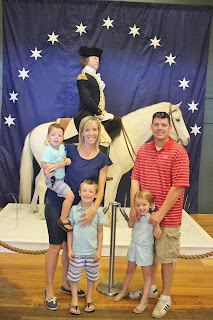


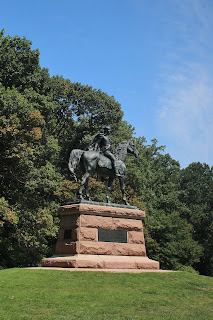
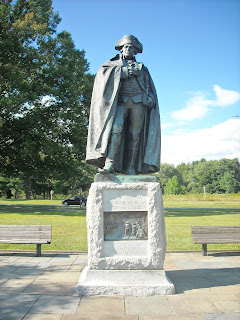


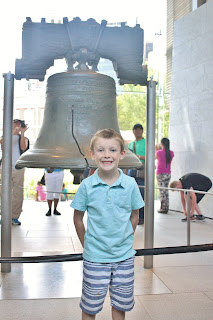












































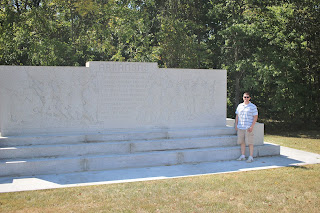
No comments:
Post a Comment